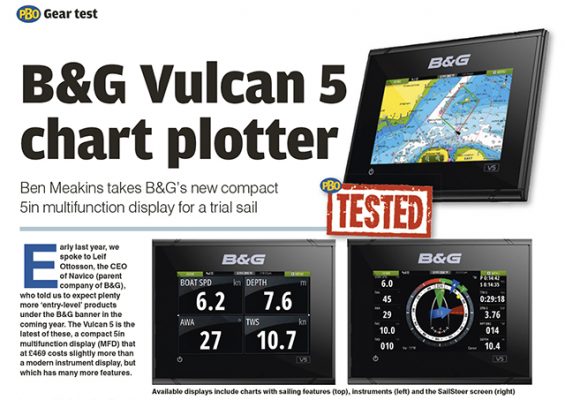Ben Meakins takes B&G’s new compact 5in multifunction display for a trial sail
Early last year, we spoke to Leif Ottosson, the CEO of Navico (parent company of B&G), who told us to expect plenty more ‘entry-level’ products under the B&G banner in the coming year.
The Vulcan 5 is the latest of these, a compact 5in multifunction display (MFD) that at £469 costs slightly more than a modern instrument display, but which has many more features.
We tested its big sister, the Vulcan 7, early last year, and were impressed by its functionality and low cost. The Vulcan 5 is from the same stable and, despite its small screen size, has many of the features of B&G’s larger plotters.
It has B&G’s Sailing features (laylines, SailTime calculations and the SailSteer screen) and can display AIS, ForwardScan and Fishfinder data (see PBO’s February issue for our test) and StructureScan data.
It’s barely bigger than a standard instrument display, which means that you could mount it alongside your instruments in the cockpit, where it could be used as an extra instrument display or a chart plotter.
Connected to compatible systems, it can be used to control your stereo and autopilot. There are race features, too: a starting timer and Wind and Time Plot screens, which display current and historical wind and other NMEA 2000 data in graph form, useful for identifying trends.
However, it can’t display radar as there is no Ethernet connection.
Ease of use
Inputting a route is a matter of tapping ‘new route’ and then adding waypoints with single taps along the way. You can then navigate the route, and the system asks you if you want to follow it forward or reverse. You can also select a point at which to start the route – handy if you were to lose power along the way.
Waypoints are equally easy to store, place and go to, and there’s a simple measurement tool.
As with B&G’s bigger plotters you can select a ‘split screen’ mode, the visibility of which we were initially dubious about, given experience with other plotters with small screens – but in practice it was easy to read, with a sensible font size.
The unit has built-in Wi-Fi, allowing you to connect to the GoFree store and download updates via a hotspot. You can damp all NMEA data, which as we found in our previous test was really useful in making sense of wind, speed, heading and layline information.
The unit can be flush-mounted, leaving only a 10mm-thick screen protruding, or you can use the supplied mounting bracket.
There are fewer small plotters available these days, so this is good news for small-boat sailors.
Viewing angles are impressive, nearing 170° each side, and it was visible even in bright sunlight and when viewed through polarised sailing sunglasses, which make some screens look blank. We tried operating it with wet hands, and it still worked well. Power consumption was around 0.3A on full brightness.
Competitors include Raymarine’s A65 plotter, with a slightly larger 5.7in screen.

PBO verdict
Early worries that the Vulcan 5 would be simply too small to be of use proved unfounded once we started using it.
The Vulcan 5 is a good, fully-featured plotter with a beautifully clear screen. With its internal GPS it would work well as a standalone chart plotter for small boats, or as part of a wider NMEA 2000 network – adding wind, speed and depth turns it into a full-featured solution. Its relatively low cost makes it a good option for larger boats too, as either a mini plotter in the cockpit or as an instrument repeater or autopilot control head elsewhere.
Note: We may earn a commission when you buy through links on our site, at no extra cost to you. This doesn’t affect our editorial independence.
PBO’s BIG Christmas giveaway – win £2,700-worth of boat kit
Our pick of Practical Boat Owner magazine's best on test over the past year is up for grabs as one…
Sailing chartplotters: Exclusive first test!
Chart plotters and instruments have been around long enough that they’re now considered standard equipment on most boats. But sailors…
Nav in a nutshell: How to use a Breton Plotter
Breton Plotters are simple to use in practice, but tricky to explain on paper – it’s much easier if you…
Nav in a nutshell: Electronic charts
Dick Everitt assesses the differences between raster and vector charts when deciding on which chart plotter to buy
Updating electronic charts
Despite the accuracy offered by digital charting, updating electronic charts is a complicated process. Here's how to keep your electronic…
Testing times on the Atlantic Rally for Cruisers (ARC)
Laura Hodgetts talks to the skippers of 20 boats on the Atlantic Rally for Cruisers (ARC), ‘the biggest downwind gear…
Winterising a boat: 61 point checklist
PBO experts offer their top tips for winterising a boat, helping to keep your vessel and gear in good condition…
Nav in a nutshell: Navigate with radar
Dick Everitt gives us a clear picture of the advantages to be gained from using radar to check our navigation
Nav in a nutshell: Navigating at night
There’s no need to be in the dark if your preparation is thorough and easy to understand, says Dick Everitt…
Nav in a Nutshell: What is a transit and how are they used in navigation
Lining up a pair of appropriate land features or navigation marks can help keep you safe, as Dick Everitt explains
Collision avoidance software
Ben Meakins puts Raymarine’s new Lighthouse AIS update through its paces in Southampton Water
How to sail to Australia from the UK in a small boat
Kate and Jonny Harrison dreamed of a round-the-world backpacking tour to Australia – but then their plans took a nautical
















